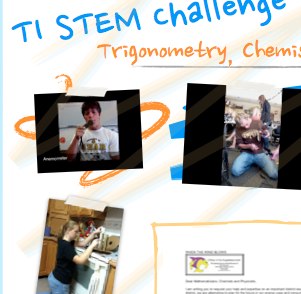When The Wind Blows

Sensor - Voltage
Fan
Basic Power Tools
Basic Hand Tools
Computer
AV equipment
Basic Chem Lab Equipment
When The Wind Blows
An investigative project based learning activity incorporating math and science through the connections among Chemistry, Physics, and Trigonometry. Project leads to consideration of the feasibility of alternative energy options based on research and local data. Student activities culminate in the design of wind-turbine models and prototype. The project can easily be adapted to all courses, or may be the focus of one class individually based on preferences, needs, materials, or other restraints.
1.Prior to engaging students, departmental collaboration for identifying course objectives is necessary to develop a flow chart* and entry document*.
2.Each course instructor should be responsible for identifying key concepts that will be covered in their objectives.
3. Construct classroom website (Google Sites is recommended) or other collaborative environment where students can share their work and facilitate discussions between courses.
4. Identify the information that will need to be shared between students in different courses (e.g. Physics students shared videos on electricity and magnetism, Chemistry students shared evaluative information on alternative energies, Trigonometry students shared recommendations for prototype design, etc)
5. Identify the necessary sequencing of course work to provide appropriate timing for shared information, as discussed above.
6. Obtain materials (material list on website).
7. Plan to meet regularly.
For additional information and documents visit the project website: http://goo.gl/I8eJj
*attached documents
1. Regular collaboration to track student progress in activities, with special focus on components that must be shared between different groups and classes.
2. Students regularly evaluate Need to Knows and Next Steps based on the Entry Document and additional information provided in the project sequence.
3. Students (and instructors) maintain communication with each other (in groups and between classes) through collaborative Google Docs, maintenance of the project website, and student blogs.
4. Instruction of concepts is maintained in each course according to the guidelines and schedules established during pre-project collaboration.
5. For additional information and documents visit the project website: http://goo.gl/I8eJj
6. Publish View document attached on webpage: http://goo.gl/bPpHK
1. Presentation of project to school board and district administrators.
2. Communication with local media for further student recognition.
3. Final collaborative meeting between instructors to identify areas that need improvement or adjustment for further implementation cycles.
4. Project scoring rubrics are available on the website: http://goo.gl/I8eJj
Before the Activity Files
During the Activity Files
Sensor - Voltage
Fan
Basic Power Tools
Basic Hand Tools
Computer
AV equipment
Basic Chem Lab Equipment
Vernier EasyData,Vernier EasyLink and Vernier EasyTemp are registered trademarks of Vernier Science Education.

